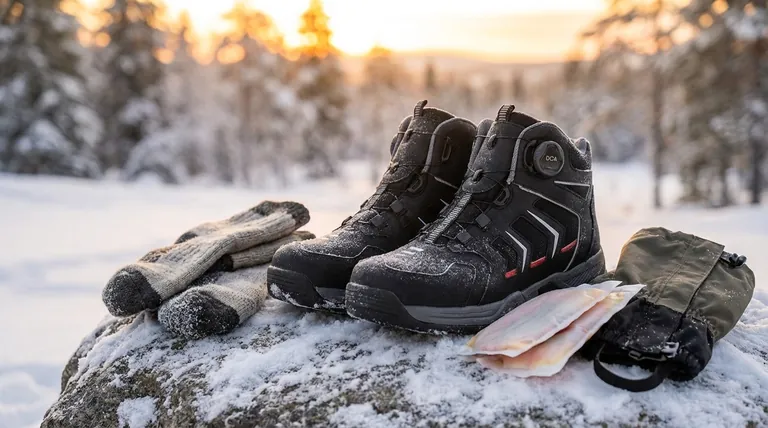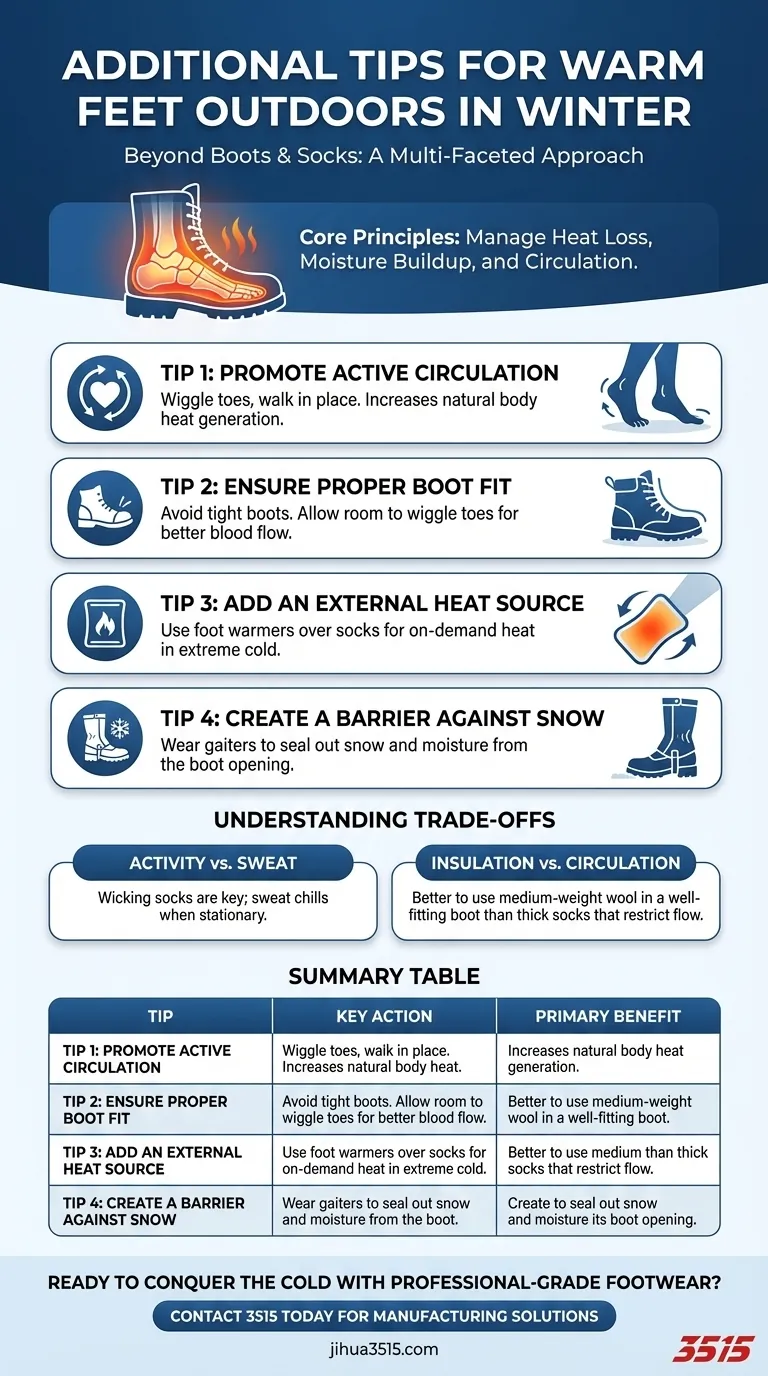In addition to good boots and socks, keeping your feet warm outdoors requires a multi-faceted approach. Key strategies include using foot warmers for on-demand heat, ensuring your boots are not too tight which can restrict blood flow, and using gaiters to prevent snow and moisture from entering your footwear.
The core challenge isn't just about insulation; it's a constant battle against moisture and maintaining proper blood circulation. A dry foot with good blood flow is a warm foot.

The Principles of Warm Feet
To truly solve the problem of cold feet, we must address the root causes: heat loss, moisture buildup, and compromised circulation.
Why Cold Feet Are More Than Just Uncomfortable
Your feet, along with your head and hands, are critical points for your body's temperature regulation. When they get cold, your entire system struggles.
This isn't just about comfort. Cold feet can lead to serious health issues like frostbite, which causes permanent damage to skin, nerves, and tissues. Maintaining warmth is essential for safety and well-being.
The Role of Blood Flow
Keeping your feet warm helps maintain healthy blood flow. Warm blood vessels open up, distributing heat more effectively throughout your body.
This process not only keeps you feeling warmer but also supports your immune system and overall energy levels during cold weather.
Advanced Strategies for Warmth
Here are specific tactics that address the core principles of warmth.
Tip 1: Promote Active Circulation
Your circulatory system is your body's natural heating system. The best way to keep your feet warm is to ensure warm blood is reaching them.
Engaging in physical activity, even something as simple as wiggling your toes or walking in place, increases blood flow and generates heat from within.
Tip 2: Ensure a Proper Boot Fit
A common mistake is wearing boots that are too tight, especially with thick socks. This is counterproductive.
Boots that are too snug restrict blood circulation, preventing warm blood from reaching your toes. You should be able to wiggle your toes freely inside your boots, even with your chosen socks on.
Tip 3: Add an External Heat Source
Sometimes, insulation alone isn't enough, especially in extreme cold or during long periods of inactivity.
Disposable or rechargeable foot warmers provide a reliable source of external heat. Place them on top of your socks over your toes for the most effective warmth without creating uncomfortable pressure points on the sole.
Tip 4: Create a Barrier Against Snow
Moisture is the enemy of warmth. Snow melting into the top of your boots is a fast track to dangerously cold and wet feet.
Gaiters are fabric guards that wrap around your lower leg and cover the top of your boot. They create an essential seal that keeps snow, ice, and water out.
Understanding the Trade-offs
Implementing these strategies requires balancing different needs.
Activity vs. Sweat
While physical activity is crucial for generating heat, it also produces sweat. Wet socks will chill your feet rapidly once you stop moving. The solution is to wear moisture-wicking socks (like merino wool) that pull sweat away from your skin.
Insulation vs. Circulation
Choosing the thickest possible socks can seem like the best idea, but it often leads to a restrictive boot fit. It's better to use a high-quality, medium-weight wool sock in a boot that fits properly than a thick sock that cuts off your circulation.
Dry Gear is Non-Negotiable
Never start a day with damp boots or socks. Moisture conducts heat away from your body at an alarming rate. Always ensure your gear is completely dry before you put it on, using a boot dryer if necessary.
Making the Right Choice for Your Goal
Your approach should adapt to your specific activity and conditions.
- If your primary focus is high-exertion activity (like winter hiking or snowshoeing): Prioritize moisture-wicking socks and a boot that breathes, and use gaiters to keep external moisture out.
- If your primary focus is low-exertion activity (like ice fishing or spectating): Emphasize high levels of insulation and external heat sources like foot warmers, ensuring your boots are not tight.
- If your primary focus is all-day comfort in mixed conditions: Layering is key—use a quality merino wool sock, ensure a perfect boot fit, and carry foot warmers just in case.
Ultimately, a proactive system that manages circulation and defeats moisture is your best defense against the cold.
Summary Table:
| Tip | Key Action | Primary Benefit |
|---|---|---|
| Promote Circulation | Wiggle toes, walk in place | Increases natural body heat |
| Ensure Proper Boot Fit | Allow room to wiggle toes | Prevents restricted blood flow |
| Use External Heat | Apply foot warmers over socks | Provides on-demand warmth |
| Block Moisture | Wear gaiters over boots | Keeps snow and water out |
Ready to Conquer the Cold with Professional-Grade Footwear?
As a large-scale manufacturer, 3515 produces a comprehensive range of durable, weatherproof boots and shoes designed for extreme conditions. Whether you are a distributor, brand owner, or bulk client, we can provide the reliable footwear solutions your customers need to stay warm, dry, and safe.
Contact 3515 today to discuss your manufacturing needs and get a quote!
Visual Guide

Related Products
- Wholesale Safety Footwear Manufacturer for Bulk & Custom OEM Orders
- Premium Wholesale Waterproof Safety Boots High Performance Protection for Industrial Markets
- Customizable Anti-Smash Safety Boots for Wholesale & Private Label Manufacturing
- Custom Wholesale Leather Safety Boots Direct Factory Manufacturing
- High Performance Fire-Retardant Waterproof Safety Boots
People Also Ask
- What's the difference between safety toe and steel toe? Choose the Right Protective Footwear.
- What is a safety-toe in a boot? Your Guide to Choosing the Right Protection
- Is there a downside to steel toe boots? Weighing Protection Against Daily Comfort
- What are the differences between steel toe, composite toe, and alloy toe Wellington boots? Choose the Right Safety Toe for Your Job
- Is safety toe better than steel toe? A Guide to Choosing the Right Protection



















